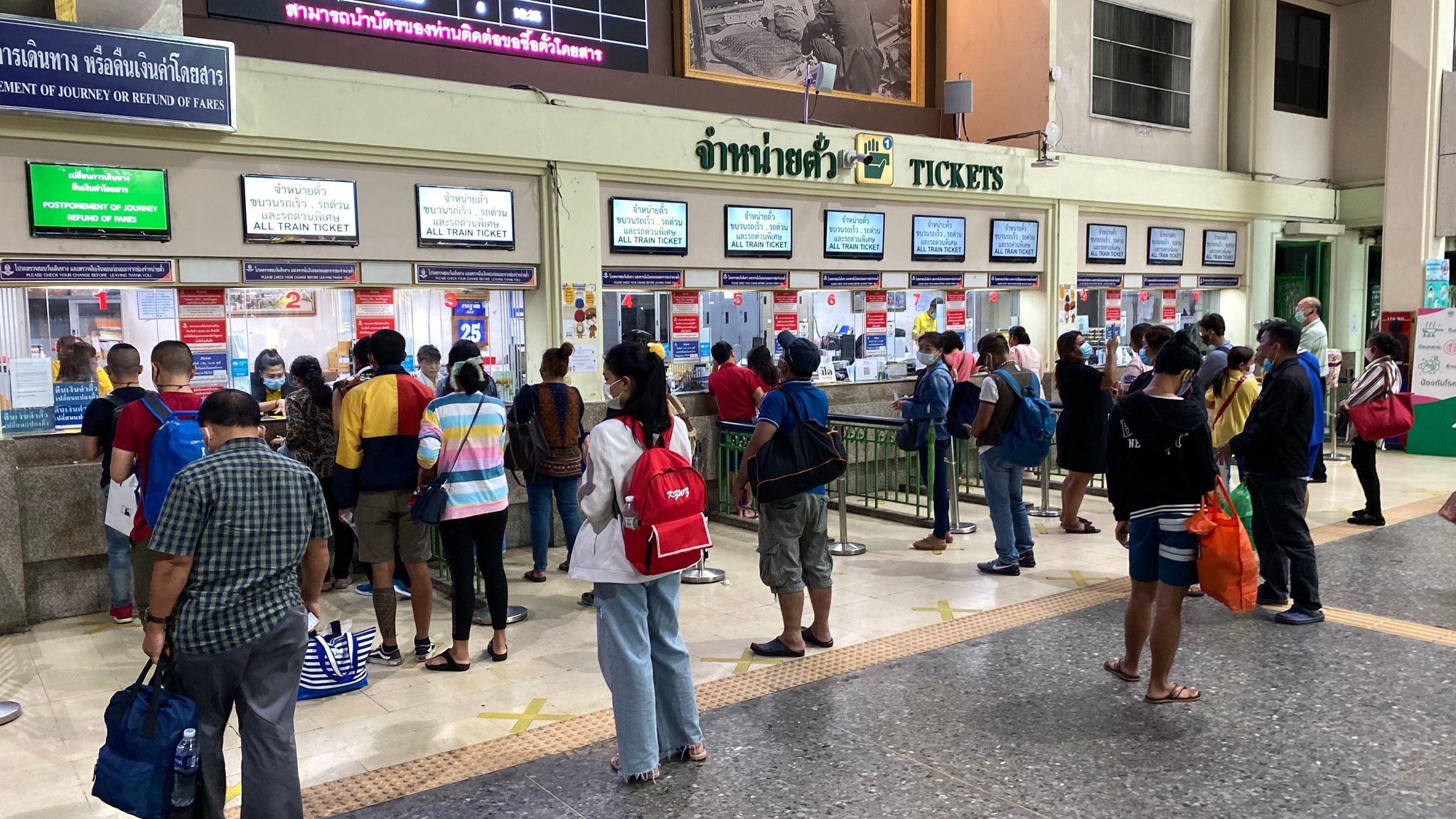Explore Thailand on The Railways: Interesting Travel Experience
Thailand, a vibrant Southeast Asian nation known for its rich culture, stunning beaches, and bustling cities, boasts an extensive train network that connects various regions of the country. This network is divided into several main lines, each serving specific geographical areas.
Let's delve into the convenience of Thailand's train routes.

Explore Thailand On The Railways
Train Routes
Northern Line
The Northern Line traverses through picturesque landscapes, offering travelers glimpses of lush forests, misty mountains, and charming rural villages.
Stations along this route include:
- Don Mueang
- Ayutthaya
- Lopburi
- Phitsanulok (for Sukhothai)
- Lampang
- Chiang Mai
North-Eastern Line
The North-Eastern Line, also known as the Isan Line, ventures through the northeastern region of Thailand, an area renowned for its unique culture and cuisine.
Key stations on this route include:
- Pak Chong (for Khao Yai National Park)
- Nakhon Ratchasima (Korat)
- Surin
- Buriram
- Ubon Ratchathani
- Khon Kaen
- Udon Thani
- Nong Khai
Eastern Line
The Eastern Line connects Bangkok to the eastern seaboard, where pristine beaches and vibrant beach towns await.
Travelers can hop on trains bound for:
- Makkasan
- Chachoengsao
- Prachinburi
- Chonburi
- Si Racha
- Pattaya
Southern Line
The Southern Line takes passengers through the tropical landscapes of southern Thailand, home to some of the country's most renowned beaches and islands.
Stations along this route include:
- Nakhon Pathom
- Kanchanaburi
- River Kwai Bridge
- Cha Am
- Hua Hin
- Prachuap Khiri Khan
- Chumphon (for ferries to Ko Tao)
- Surat Thani (for ferries to Ko Samui and Ko Pha Ngan)
- Nakhon Si Thammarat
- Phatthalung
- Hat Yai
- Trang
Seat Types
Traveling by train in Thailand offers a variety of seating options to suit every budget and preference. From luxurious cabins to basic seats, passengers can choose the level of comfort that best fits their needs.
1st Class Sleeper
First-class sleeper cabins offer passengers spacious and private accommodations for overnight journeys. While they are the most luxurious option available on Thai trains, they also come with a higher price tag.
These seats are primarily found on Express and Special Express trains operating on long-distance routes. Due to their popularity and limited availability, it's advisable to book well in advance.

1st Class Sleeper
2nd Class A/C Sleeper
These choices are highly favored by foreign travelers, particularly on popular routes like Bangkok to Chiang Mai, Bangkok to Surat Thani, and Bangkok to Nong Khai. These seats are converted into upper and lower bunks for overnight journeys, with lower bunks being slightly more expensive.
All seats offer amenities such as air-conditioning, privacy curtains, pillows, and blankets. They are commonly found on Rapid, Express, and Special Express trains operating on long-distance routes.
It's recommended to pack light and bring essential items for a comfortable night's sleep.

2nd Class A/C Sleeper
2nd Class A/C Seat
These seats offer airplane-style seating in air-conditioned carriages, featuring armrests and fold-down tray tables for added convenience.
These seats are widely available on most Rapid, Express, and Special Express trains operating on long-distance routes. They are the preferred choice for passengers seeking a comfortable seat-only option, especially for day trips.
Choosing a seat by the window allows for scenic views along the way.

2nd Class A/C Seat
2nd Class Fan Sleeper
2nd Class Fan Sleeper Seats do not have air conditioning, instead featuring small ceiling fans. They are typically found in older carriages and are about 30% cheaper.
However, they can become uncomfortably hot at night due to ineffective fans. These seats are mainly available on long-distance Rapid trains along the Northern, Southern, and North Eastern lines.
Booking the lower bunk allows passengers to open the window for ventilation. Bringing along a portable fan or dressing lightly can help enhance comfort during the trip.

2nd Class Fan Sleeper
2nd Class Fan Seat
2nd Class Fan Seats are padded chairs in pairs facing the direction of travel. The carriage is cooled by fans, and windows can be opened with shutters to block strong sunlight.
These seats are generally comfortable for shorter day trips but may offer lower comfort for long journeys or overnight services.
They are available on most Rapid and Express services along the Northern, Southern, and North Eastern lines. Carrying a personal fan can help alleviate discomfort in hot weather.

2nd Class Fan Seat
3rd Class Seat
3rd Class seats are the cheapest but least comfortable option on Thai trains. These carriages are often full, seating is on benches, and while some services have small fans, they are typically not air-conditioned.
Available on Ordinary, Rapid, and Express trains, 3rd Class seats can only be purchased on the day of travel at the departure station. You should wear breathable clothing and bring a small handheld fan to stay cool.

3rd Class Seat
Way To Buy Tickets
Online
Purchasing train tickets online in Thailand is a convenient option that allows you to secure your seats in advance. You can use official websites like the State Railway of Thailand (SRT) or trusted third-party booking platforms.
You should double-check your travel dates, departure times, and seat preferences before confirming your booking.
At the station
For those who prefer purchasing tickets in person, train stations across Thailand provide this option.
Arrive early to avoid long queues, especially during busy travel times. You should be prepared to pay in cash, as credit card acceptance may vary depending on the station.

Easily Book Tickets At The Train Station
Tips When Traveling By Trains
- Book In Advance
Securing your tickets well ahead of time can ensure you get the seats or accommodations you prefer, particularly during peak travel seasons when trains tend to fill up quickly.
- Arrive Early
Arriving at the station with plenty of time to spare before your train's departure allows you to avoid rushing and ensures a smoother boarding process.
- Be Mindful Of Valuables:
While train travel is generally safe, it's essential to remain vigilant and keep your belongings secure at all times. Keep your valuables close to you and avoid leaving them unattended, especially in crowded areas.
- Stay Informed
Stay updated on your train's schedule, stops, and any potential delays or disruptions by checking for real-time updates from railway authorities or using travel apps and websites.
FAQs
- Are trains good in Thailand?
Yes, trains in Thailand offer a convenient and affordable way to travel between cities and regions. While the infrastructure may vary, especially on older routes, trains generally provide comfortable seating options and scenic views of the countryside.
- What is the best time of year to train in Thailand?
The best time to train in Thailand is during the cooler, drier months from November to February. During this period, temperatures are more comfortable, and there is less chance of encountering heavy rainfall or humidity, making for a more enjoyable journey.
- Are trains expensive in Thailand?
Train fares in Thailand are generally affordable, especially for lower-class seats. However, prices can vary depending on the class of service, route, and distance traveled. Higher-class seats, such as first-class sleeper cabins, may be more expensive but still offer value compared to other modes of transportation.
BestPrice Travel
Image source: Internet








